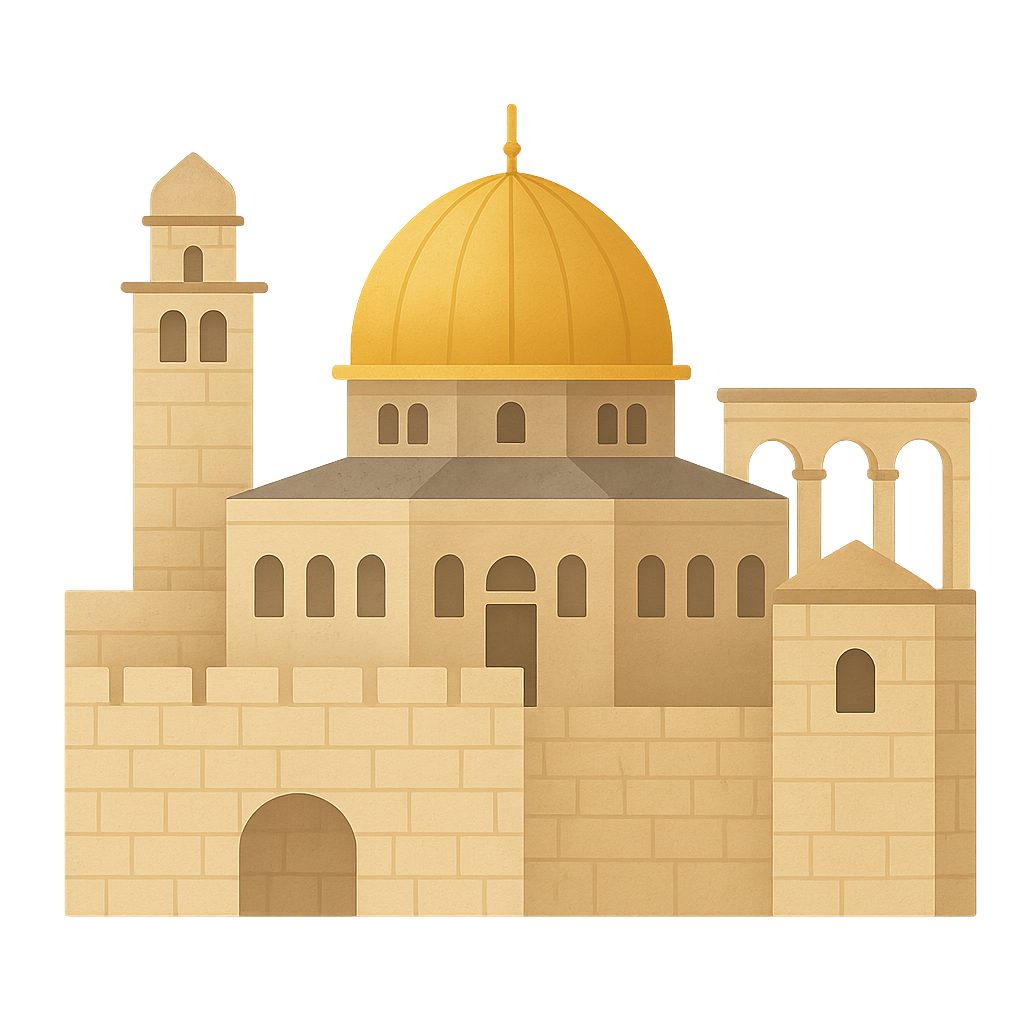The City of a Thousand Stories
The sun warms my stones, turning them the color of honey and gold. For thousands of years, I have felt this same sun rise over the hills that cradle me. In my narrow alleyways, the air is thick with the scent of cardamom, cumin, and ancient incense, mingling with the fresh aroma of baking bread. If you listen closely, you can hear a symphony of sounds: the murmur of prayers from different faiths, the ringing of church bells, the call of the muezzin, and the joyful shouts of children playing on cobblestones worn smooth by time. I am a living library, where every corner holds a secret and every stone has a story to tell. My memory is long, stretching back through empires, kingdoms, and the footsteps of prophets and pilgrims. I have watched generations come and go, each one leaving an echo within my walls. I am a city of whispers and dreams, a place sacred to so many. I am Jerusalem.
My story as a great capital began long ago, around the year 1000 BCE, with a king who was also a poet and a warrior. His name was David, and when he looked upon my hills, he saw not just a fortress, but the heart of a nation. He chose me to unite his people, making me the capital of his kingdom. It was a time of great hope and new beginnings. After him came his son, Solomon, a king known for his incredible wisdom. Around 957 BCE, Solomon built a structure of legendary beauty upon one of my highest points: the First Temple. It was magnificent, with walls of cedar and details of pure gold. It wasn’t just a building; it was a promise, a central place for people to gather in faith and celebration. Pilgrims traveled for weeks to reach my gates, their hearts filled with song. I became a beacon, the center of their world, a place where heaven and earth felt a little closer. This Temple made me the spiritual core of the Jewish people, a role I have held in my heart ever since.
As centuries passed, my story grew deeper and more complex, weaving in the beliefs of new faiths. I became a holy place for Christians, who followed the footsteps of a teacher named Jesus. They believe he walked my cobbled streets, taught in the courtyards of the Temple, and that his life's most important moments happened here. To this day, pilgrims trace his path along a route called the Via Dolorosa, their hearts full of reverence. Then, another chapter of my spiritual story was written. For Muslims, I became sacred through an event known as the Prophet Muhammad's Night Journey, which began in Mecca and led him here around the year 621. From a sacred rock on my holy mountain, he is believed to have ascended to the heavens. To honor this spot, a breathtaking shrine was built in 691 CE, the Dome of the Rock. Its golden dome shines like a second sun, a beacon of Islamic faith. Over the ages, many rulers have held me—Romans arrived in 63 BCE, Christian Crusaders in 1099, and the great Ottoman Empire began its long rule in 1517. Each group left its mark, building new structures and adding new layers of history, but they never erased the stories that came before. I became a crossroads where different worlds met.
If you visit me today, you will see the strong, high walls that hug my oldest part, the Old City. These aren't my first walls, but the ones you see were rebuilt by a powerful Ottoman sultan named Suleiman the Magnificent. Between 1537 and 1541, his builders worked tirelessly to give me the grand, protective embrace I still have. These walls are more than just stone; they are the arms that hold my history together. If you walk through one of my ancient gates, like the Jaffa Gate or the Damascus Gate, you will find a vibrant world inside. My Old City is divided into four quarters: the Jewish, Christian, Muslim, and Armenian Quarters. Each has its own unique character, its own sounds and smells. You can wander from the quiet courtyards of the Armenian Quarter to the bustling markets, or souks, of the Muslim Quarter, where merchants sell colorful spices and handmade crafts. You can visit the Western Wall in the Jewish Quarter, a sacred place of prayer, and then walk to the historic churches of the Christian Quarter. Children's laughter echoes in the narrow lanes as they play games their ancestors might have played, living their lives side-by-side within the shelter of my walls.
My heart still beats strongly, connecting the ancient world with the modern one. Just outside my historic gates, a new city has grown, with sleek trams, busy cafes, and modern buildings. Yet, the old and new do not erase each other; they exist together, a reminder that my story is always moving forward. People from every corner of the globe still come to me. They come not just to see old stones, but to feel a connection to something timeless. They walk my streets, listen to the echoes of the past, and add their own footsteps to the millions who have come before. Despite a history filled with conflict and disagreement, my truest treasure is my power to inspire. I am a reminder that so many different stories can exist in one small place. My ultimate hope is to be a city that teaches the world to listen, to respect one another's histories, and to dream of a future where peace is the most sacred story of all.
Reading Comprehension Questions
Click to see answer
